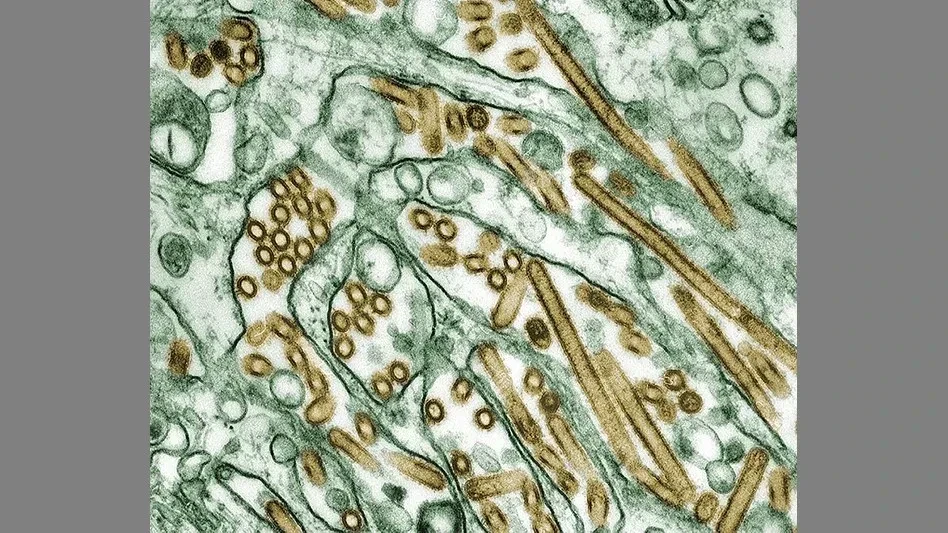 In a 2011 photo, Chiquita/FreshExpress Raw Product Food Safety Manager Sharan Lanini and Director of Research & Development Diego Luzuriaga examine lettuce leaves. (Photo: Patrick Tregenza) |
Over the last decade, the diet of the American consumer has seen a great deal of change. And this has been both impacted and shaped by continued advances in food safety, quality, and defense.
Food manufacturers are seeing more consumer desire for healthy foods year-round, along with greater demand for food safety and quality, despite the increased challenges inherent in products generally defined as “healthier” and those which must be sourced globally.
“There is an increased awareness of food safety issues across society,” said Vice President of Global Quality and Food Safety Mike Burness of Chiquita Brands International. This is due, at least in part, to the expansion of the Internet and consumer and media capability to find and disseminate information. However, he added, “Consumers are exposed to vast amounts of information today. This often shapes their perspectives and opinions, resulting in an opportunity for us to ensure we do everything possible to help consumers understand this information so they can make an informed purchasing decision.”
Healthier Eating.
When consumers think of healthy foods, the primary focus is fruits and vegetables. However, just because a food is inherently healthier doesn’t mean that it is inherently safer. In fact, such foods may pose greater food safety risk because they are not as processed and do not get cooked or heat processed. “Fresh fruits and vegetables are an essential part of a healthy diet and are grown under strict and extensive food safety programs,” Burness said. “These programs have resulted in a very safe and sufficient supply of fruits and vegetables, even though the products are grown outdoors.”
This is even more pronounced when dealing with organic foods. “Consumers sometimes think that because a food is organic, it’s safer. In fact, due to the requirements for making organic produce, many agrichemicals and certain processing steps used in conventional produce manufacturing for minimizing risk cannot be used.”
“The movement toward healthier eating is a good thing, but it comes with certain tradeoffs.”
Globalization.
A similar challenge exists in providing consumers with non-native foods or ingredients and year-round fresh produce. With the globalization of the food supply, Burness said, “There’s a lot of product coming from places from which we didn’t source in the past.” This means that there is more exposure to issues of not only food safety but also quality and defense. The most common thread in changes to our food system over the last decade is this globalization. While it brings more consumer choice, it also carries challenges: there is more exposure to food safety issues; there is greater chance for problems of food defense; and it completely changes the game in quality. “Variation in quality across the global supply chain is vast,” he said.
Yet, the industry is beginning to see a new normal in this area with the growing focus on global standardization being driven by the industry as much as by regulation. In the 1970s, HACCP was introduced to the food industry, with Pillsbury becoming the first to use the NASA-developed program as a food-protection system. Since then, HACCP has not only become a USDA requirement, it has been adopted across much of the industry for food safety, and it, and GFSI, formed the basis for much of FSMA’s pre-requisite and risk-based requirements.
However, Burness said, “Not everyone employs the use of HACCP—and that is the opportunity going forward.” But even more importantly, he said, it is a question of culture. “We need to start creating and maintaining food safety cultures instead of food safety practices.”
Scientific Advancement.
The past decade has also seen some balancing factors in the advances in food science enabling an understanding and prevention of potential risk. “Pathogen detection is much greater and much faster,” Burness said. “We have greater capability now to connect the dots to find and prevent contamination and public health issues.”
Burness sees the 2006 spinach E. coli 0157:H7 crisis as “the watershed food safety event in produce.” Since then the industry has implemented much more comprehensive food safety systems across the supply chain. Additionally, industry developed more of an understanding of some of the mechanisms of bacterial contamination of produce, with an emphasis on understanding the effects of E. coli 0157:H7 and “how it finds its way into produce,” from which effective strategies and mitigation steps have been developed and implemented.
“The area of pathogen detection and prevention in produce used to have a steep learning curve, but with advances in science, we have been seeing that flatten out quite a bit,” Burness said. “We are much better at detecting lower levels of particulates, chemicals, nutrients, and potential contaminants in food.” The challenge, then, is understanding the level at which a potential “contaminant” becomes relevant. For example, he said, numerous government and global organizations (e.g., EPA, CODEX, etc.) have done extensive research on the impact of pesticide residues, and published generally acceptable levels of these in food.
On the other hand, E. coli 0157:H7 has a very low infectious dose, so there is a need to go as low as possible in detection. Thus, scientific advancement in this area results in a benefit and an opportunity, Burness said. “The benefit is that we have the ability to detect lower and lower levels of many things in food; the opportunity is to define and apply the right level to maximize public health protection and consumer choices.”
Quality.
Today’s customers are increasingly discerning as relates to the quality of the food they purchase, and Burness sees much of this as driven by the increased quality of private-label foods. “The differentiation of quality between private label and brand name foods is not what it used to be,” he said. In the past, private label was seen as “no frills” and of lesser quality, and often carried a lower cost reflecting that. As technology advanced, science was able to quantify attributes that consumers could previously describe only qualitatively. Translating these product quality attributes into consumer preferences helped close the quality gap between private label and branded products, often without significant investment.
Then, as the economy changed, consumers became more price conscious and often tried less expensive food options; where quality had increased on these items and were considered by consumers to be acceptable compared to branded products, many consumers stayed with them. However, Burness added, “As the economy continues to improve and consumers become more discerning, I think we will start seeing branded products getting more attention. We are seeing this now in many developing countries.”
Food Defense.
Ten years ago, food defense was a relatively new idea, coming on the heels of 9/11 and the Bioterrorism Act. Today, food defense has become a standard program in many food companies, but even it has changed since 2003. At that time, Burness said, many risk assessment models considered risk as coming from outside in; then, as more intelligence was gathered and analyzed, the models morphed to consider the risk as from inside out. For example, today it is not uncommon to see background checks on employees prior to hire, and many companies are also repeating checks at routine intervals across an employee’s tenure.
The general approach to food defense has also changed and become more focused. There often was overlap between food defense and food safety, how to approach the two, and whether they could be conducted together or required separate programs. This confusion has lessened greatly over time, with food defense programs becoming fairly standard across the industry. However, there are areas where the two still can and do overlap. With traceability, for example, the concept of one-forward/one-back initiated with the Bioterrorism Act, yet it is really a pre-requisite that serves both masters—food defense and food safety, Burness said. In fact, he added, it has become just as essential in food quality. First, it was the right thing to do and a fundamental element of a comprehensive food safety program, then it became a regulation, now traceability is critical to the infrastructure of any food company as well as companies in many other industries.
The Future.
As to the next 10 years for the industry, “I think the big impact on food processing will be the continued globalization of the food chain,” Burness said. As countries develop, consumers become more discerning, and regulation increases, we will likely see a “flattening of the world,” he said.
“We’re not there yet, and there’s a lot to do,” he said, adding that he would expect the evolution of food regulations to move toward the neutraceutical/pharmaceutical model over time, with standards becoming more consistent around the globe.
“Where you see differences today, I think they will smooth out over time.” And it will happen, at least in part, because consumers will expect and demand the same food safety and quality no matter where the product comes from.

Explore the August 2013 Issue
Check out more from this issue and find your next story to read.
Latest from Quality Assurance & Food Safety
- Nestlé Opens Arizona Beverage Factory and Distribution Center
- Ingredion Invests $100 Million in Indianapolis Plant to Improve Efficiency, Enable Texture Solutions Growth
- Eagle Unveils Redesigned Pipeline X-ray System
- USDA Invests Up To $1 Billion to Combat Avian Flu, Reduce Egg Prices
- Washington Cats Confirmed with HPAI as Investigation into Contaminated Pet Food Continues
- USDA Confirms Bird Flu Detected in Rats in Riverside
- Kyle Diamantas Named FDA’s Acting Deputy Commissioner for Human Foods
- QA Exclusive: Food Safety Leaders React to Jim Jones’ Departure, FDA Layoffs





